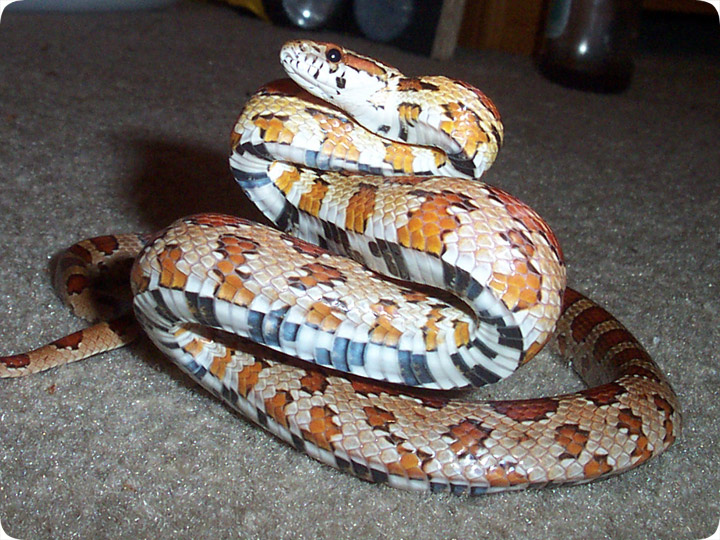-
info@aaanimalcontrol.com
Call us for help in your town
Humane Wildlife Education
Orlando Florida Snake Charmer

03.20.2004 - Here is a fine photo of one of my favorite snakes, the Corn Snake. This is a fairly small specimen, but it's just as pretty as any of them. It's got
beautiful auburn scales with orange spots, lined in black. The belly has a black and white keyboard pattern, which ye people of olde likened to maize, and that's how this
snake got its name. I sometimes like to play with the snakes I catch, and so I used my expert snake charmer techniques on this snake. I twirl and wiggle my finger
in a certain way, and the snake watches, mesmerized. I bring the finger closer, closer, and the snake coils up upon itself, watching the finger. Soon, the snake is
in the above pose. It works every time.
Trapper David* the snake charmer
Charming the Florida snakes
He doesn't have to wear snake armor
He never makes
mistakes
No snake would ever dare strike him
They all are quite surprised
They know that they somehow like him
And find themselves
mesmerized
With a whirl and
twirl of his finger
And a knowing wink of his eye
All serpents choose to linger
And let the time pass by
Slowly they rock from side to side
As if they've been
put asleep
He's taken them on a charming ride
Both hypnotic and deep
No need for traps or snake bags
It's easy to disarm them
Trapper David makes brags
About
how he simply charms them
*Trapper David doesn't necessarily refer to me, it could be any one of a number of trapper Davids who catch snakes in the Orlando area, or else
I would have written this poem in the first person, you see.
Do it yourself: Visit my How To Get Rid of Snakes page for tips and advice.
Get professional help: Visit my Nationwide Pro Directory of wildlife removal experts.
For more wildlife stories, click my Wildlife Blog
or click my below banner to hire a local trapper.
You can also catch snakes with a special trap, which you can order by clicking this banner:

Snake charming is a fairly common practice likely originating from India with some ties to Ancient Egypt. Snake charming is the practice of appeasing a snake, often through a type of hypnosis using an instrument called a been or more commonly a pungi. Traditionally, especially in India, snake charmers charm king cobras but some snake charmers prefer to use various species of vipers and pythons. Snake charmers are largely a dying profession now because of a few reasons. First, owning snakes was made illegal in India in 1972. Additionally, snake charmers are forced to live a nomadic-like existence, traveling from town to town and collecting tips as their payment; it’s not a very sustainable trade. And of course, snake charming is not a safe profession by any means, effectively discouraging a lot of people from participating in it.
The way snake charming is presented is extremely misleading. The snake charmer isn’t actually charming the snake as much as they are making themselves a predator to the snake. The snake can’t hear the music (they don’t have ears) as much as it can sense the pungi, which makes the snake wake up and look towards the music. Then they’ll follow the pungi and snake charmer with their head, tracking them as if they were looking to eat the snake and the snake is getting ready to defend itself. It will look like the snake is moving to the beat but in reality, they’re just trying to make sure that their “predator,” doesn’t get them. Before performances snake charmers sometimes make sure to not feed the snake quite enough so it’s rather sluggish anyway. Some snake charmers go to the extent of taking the fangs or venom glands out of their cobra or even sew the snake’s mouth shut to ensure it won’t be a danger to them or their audience. These cruel practices are not traditional in India, they’re just what modern snake charmers tend to do in the interest of safety.
Hindus and Ancient Egyptians believe that the serpent was sacred and anyone that could train the serpent is holy. In early India and Ancient Egypt, snake charmers were well educated and respected men that were shamans, magicians, and healers. These ancient snake charmers would treat various snake bites, remove snakes from homes and gardens, be used to spark a new spiritual chapter in an individual’s life, and create antivenins. All of these uses would enable snake charmers to have an impressive status, education, and social life in these ancient communities.
Today, snake charmers add to their act by making juggling and sleight of hand tricks part of their repertoire. An example of a common sleight of hand trick would be one that goes back to Moses and the Bible, turning a rod into a snake. Sometimes snake charmers will make their snake fight an animal like a mongoose. Usually, this doesn’t end in either of the animals dying because the snake doesn’t have any venom and the charmer won’t let their snake die. Although snake charming may be considered a cruel practice by today’s standards, snake charming has an extremely impactful history and spiritual value in many communities.




















